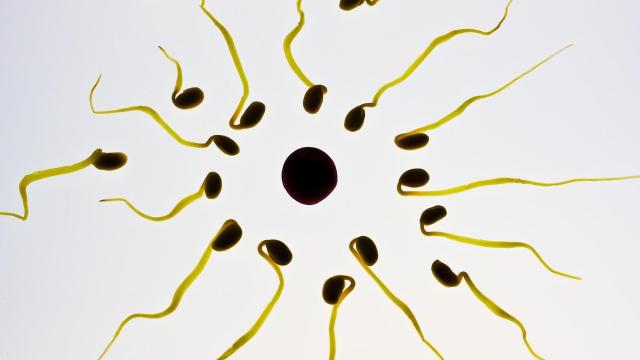A study that claimed to overturn our understanding of how sperm moves has now been retracted. The research had suggested that sperm cells propel themselves forward through complex spins that created an optical illusion of them only swishing their tails back and forth under a microscope. The authors now agree that their conclusions can’t be supported by the data they’ve collected so far.
In late July 2020, UK mathematician Hermes Gadelha and his team at the University of Bristol published their study in Science Advances. Their work, which included collaboration with researchers from Mexico, involved taking high frame rate photos of sperm as they moved through a fluid, low-friction environment. From these images, they created a 3D model of how these cells were likely moving.
Based on their modelling, the team argued that our current thinking of sperm motion — the side-to-side lashing of the sperm’s tail you can see under the most primitive of microscopes — was wrong. Instead, they theorised that sperm spin their tails asymmetrically in one direction while also rotating their heads concurrently. On a 2D plane, they added, this movement would look like the classic tail-swishing we associate with sperm. Gadelha told Gizmodo at the time that this complex routine might resemble the motion of otters corkscrewing through the water.
Even at the time, though, an outside expert in sperm motion told Gizmodo that he wasn’t entirely convinced by the team’s work and that at least some of their conclusions may have been too “strongly worded” — caution that now seems to have been prescient.
On Aug. 1, 2020, the journal issued an expression of concern about the paper, after Gadelha’s team brought up concerns from other scientists critical of the team’s mathematical analysis. The journal promised that the authors would reevaluate their data given these concerns and report back. Earlier this May, the journal agreed to retract the study entirely, after the authors admitted that their central premise couldn’t be justified by their data alone.
“After publication, readers identified that although our 3D flagellar experimental data and analyses are sound, the conclusion of flagellar asymmetry and anisotropy cannot be drawn unequivocally using only 3D flagellar waveform data,” the authors wrote in a note accompanying the retraction. Gizmodo reached out to Gadelha, who has not yet responded, regarding this development.
Retractions are an uncommon but routine part of science. Sometimes, they happen due to outright fraud or negligent research practices. But retractions can also happen because of innocent mistakes made in the collection or interpretation of data that aren’t caught in time. This reality is one reason why replication is so important to the scientific process since it’s harder (but not impossible) for multiple groups of scientists to get the same flawed results.
In this case, it’s not necessarily that Gadelha and his team’s findings are entirely wrong. Other research has suggested that sperm do seem to rotate while moving at least sometimes. And it’s likely that sperm motion is more complicated than the eel-like movement you might see in movies. Plenty of scientists are continuing to study how these cells function and move, so this may not be the death knell of corkscrewing sperm just yet.
But this saga ought to be a reminder to both readers and journalists that no single study should be seen as the final word on something — especially if the study is making very bold or exotic claims about how the world works.
